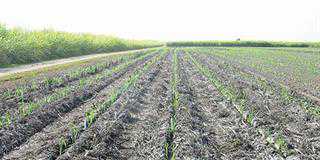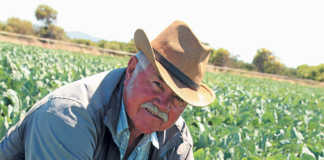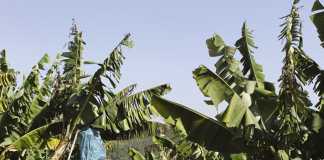<p>He diversified to dry beans, maize, sunflower and livestock, employs strict financial discipline and farms on a cash basis. Annelie Coleman visited him on his farm Rietkuil, between Potchefstroom and Ventersdorp.</p> <p><strong>Tom van Rooyen follows</strong> <br /> a five-year rainfed cash crop rotation cycle of maize, maize, dry beans, maize and sunflower. “The economic risks make monoculture cropping impossible,” he explains. “A fallow land system can’t work either, as we don’t have the watertable soils of the Free State. Farmers here deal with very hard soils, mainly Hutton, that don’t retain moisture well. Only a small percentage of Tukulu soils occur. I have to use all the land optimally, and I do this by diversifying.” Tom modestly declined to give any statistics on the scale of his operation, and would rather concentrate on the benefits of grain diversification.</p> <p><strong>Dry beans</strong><br /> He is the only farmer in his area to plant dry beans. “Beans spread the economic risk and extends the planting season. It increases my cash flow and simplifies financial planning. I don’t have to sell my maize immediately after harvesting and can store as much of it as necessary to sell at a higher price later,” he says. “The dry bean planting season starts in January, at the end of the maize and sunflower planting season. This enables the optimal use of equipment that doesn’t stand idle for months on end. <br /> “I market the beans directly after harvesting. This year we received up to R6 600/t compared to last years’ R7 000/t, at an average yield of 1,6t/ha. Dry beans also put nitrogen back into the soil. I harvest dry beans first, then sunflowers and maize. I plant the Tebus and Tebus RR Small White Haricot cultivars, supplied by the Dry Bean Producers Organisation.”</p> <p><strong>Sunflowers and maize</strong><br /> “I only use Pannar sunflower cultivars, and try not to plant too early. The time of planting is largely based on market trends and prices. If prices for delivery early in the next year are favourable, I plant as early as possible. I also switch to sunflower if I can’t plant maize in time. Sunflower is quicker and harvesting is earlier, and in our area sunflower isn’t very disease-prone. Through proper management and crop rotation, Sclerotinia stem rot no longer poses a serious problem.”The risk of producing maize in this predominantly Bankenveld area (see box: Say what?), with an annual average rainfall of 550mm, is increasing because of low prices and high input costs. Tom plants drought- and disease-resistant cultivars of all crops, using the official Agricultral Research Council (ARC) cultivar trail reports and his own on-farm trials as a guideline. It’s crucial to increase yield optimally and add value on all levels. “So I’m converting to precision farming,” he explains. “My first priority is to balance the soil. An annual soil analysis ensures the right pH and cation (including calcium and magnesium) balance. I plant maize at a density of 18 000 plants/ha, in 2,3m rows. My average maize yield is 5t/ha, comparing well with the profitability of water-table soils.”</p> <p><strong>Fertilisation<br /> </strong>Tom fertilises conservatively. He engages experts to analyse his soils every year and to map out the chemical fertilisation needs. He rotates chemical and organic fertilisers year-on-year to improve soil quality. “The fertilisation programme is based on the previous season’s yield and long-term production goal,” he says. “I add lime according to soil analysis results. Well-balanced soil absorbs moisture and fertilisers far better, increasing yield.” Tom works lime into the soil – the only time he really tills the soil – and follows a cover mulch programme using only a chisel plough as far as possible. A self-modified Super 18-tine ripper sorts out all serious compaction problems.</p> <p><strong>Weed management</strong><br /> The rotation system allows Tom to keep his land weed-free. In his farming career he has never delivered a load of grain with any trace of declared weed seeds. “The rotation cycle makes it easier to tackle weeds that would be difficult to destroy with maize production, as maize weeds are easier to combat during the sunflower cycle, and vice versa,” Tom says.“The same principle applies to disease prevention. For example, Diplodia can be transferred from maize to sunflower, but the cycle is broken by dry beans. By keeping the lands clean, I eliminate the weed seed bank in the long run.” Every land is hand-hoed before the harvesting season and declared weeds such as olieboom are removed and burned to prevent future seed germination. With maize, herbicide is applied on the row at planting time, followed by a general application after top dressing. The lands are also mechanically hoed if necessary. “In the case of sunflower, I either apply herbicide on the rows before planting or during planting. Both methods must be followed by mechanical hoeing,” Tom explains. “I keep the dry bean lands weed-free until December, either chemically or mechanically, using a 7m or 10m Handicult, depending on the infestation level.”</p> <p><strong>Incorporating livestock <br /> </strong>Tom buys stud bulls for his commercial Bonsmara herd, as top-class bulls improve the herd’s genetics and increase profit per hectare with top-class weaners. “I prefer smaller- to medium-frame cows. Our average weaner weight is 240kg and the calving percentage is never lower than 85% in relation to the number of females mated. I select strictly for calf weaning at a high percentage of the dam’s liveweight,” he says.<br /> <br /> “Livestock is an additional source of income. That’s why I only buy land with grazing and arable portions. The cattle are run on natural grazing (mainly sweet veld with some sourveld in the kopjes) and maize stover in winter, in both cases supplemented with a Dundee lick. “However, some of the cattle permanently remain on veld because of limited available maize stover. My calculations show that maize residue adds an additional R300/ha to the farm turnover.” Tom recently invested in a nucleus Boran stud herd. “I needed to diversify even more. Borans are very expensive and I’m slowly growing my herd through embryo flushing, using Bonsmara cows as recipients. “The Boran can be marketed directly off the veld with very little backgrounding. It’s a hardy, veld adapted breed, doesn’t graze selectively and is exceptionally parasite resistant.”</p> <p><strong>The cash farmer – a rare breed indeed <br /> </strong>Tom is an active member of Grain SA and Agri North West. Increasing his cash flow through diversification has enabled him to steadily expand since joining his father Mike (80) on the farm in 1990. <br /> “I farm on a cash basis. It lowers production costs because I pay no interest on foreign capital. I can buy inputs at reduced prices during the off-season, and I only buy something when it’s urgent,” says Tom. “I always know how much stock I have available since I keep records of the expenditure and income on every single land. It’s vital to know my financial position down to the last cent. I also invest in property as it doesn’t take a lot of my time and it’s wise to have investments outside agriculture. “To be a ‘cash farmer’ doesn’t mean keeping all my money under my bed. It means that my business funds itself and I don’t have to use production loans or hire purchase equipment or vehicles. I avoid loans for buying land as far as possible and only borrow the minimum amount. That means I save a lot of money on interest.”</p> <p><strong>Tom’s aspirations </strong><br /> “I dream of a well-established Boran stud in 10 year’s time. I also dream that South Africa will be one of the major exporters of grain in 2010 and that we will be in a position to add value locally through a well-established grain processing industry,” he says. “My dream is to have a processing plant on the farm for my own produce. Maybe something like a top-quality breakfast cereal.” Contact Tom van Rooyen on 082 586 0444 or 018 297 2455. |fw</p> <p> </p>
‘Don’t plant yourselves out of business’
Maize farmers mustn’t plant themselves out of business, but rather diversify to other crops and livestock for long-term survival, says Tom van Rooyen, a 2010 Grain SA Grain Producer of the Year finalist.<













